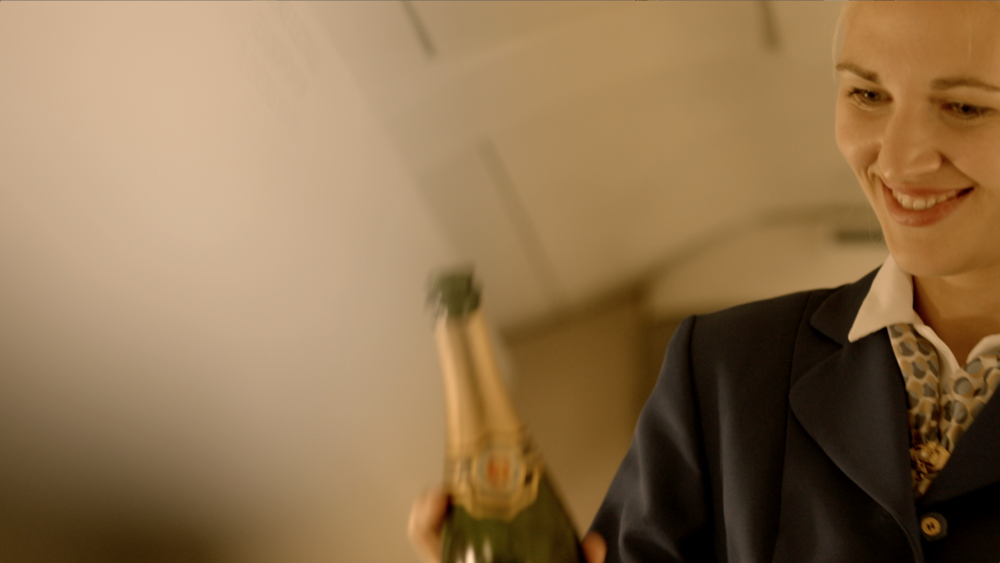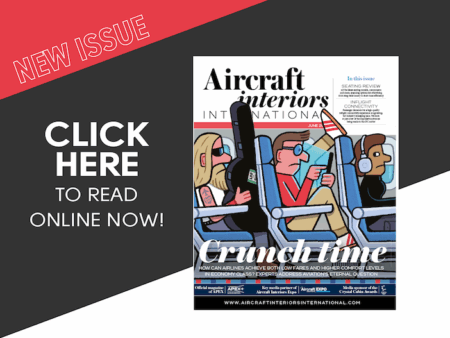Throughout the 27-year operating history of Concorde (1976 – 2003), aircraft cabin designers had to wrestle with the challenge of how to make the jetliner-interior environment appeal to the hearts, minds and sensibilities of aviation’s top net-worth market segment.
Talk about a cramped cabin: a 16in-wide aisle, 17in-wide seats, 37/38in seat pitch and passport-size window-panes only 4.5in across. Welcome to the world of Supersonic Transport (SST).
Manufacturers, vendors, suppliers and airline employees were all made fully aware of the rigorous SST standards that had to be met. There were unprecedented constraints in terms of onboard weight limits, methods of application for surface coverings, and the use of soft furnishings. The main objective was that the cabins should look streamlined, hi-tech, professional, unfussy and timeless. Subsequently, the stylings associated with the Concorde fleet were emulated by airlines worldwide when they upgraded their own first- and business-class cabins.
Note for aircraft interior design departments: In many of the premium-economy class cabins launched in the past decade, it is clear that the Concorde-interior “look” has had a powerful effect on the thinking of airline marketing managements.
Supersonic glamor
Concorde ‘regulars”’ still rhapsodize about the thrill of traveling faster than a rifle bullet, at twice the height of Mount Everest, and at twice the speed of sound (a blue light pulsed through the cabin when the aircraft exceeded Mach 1). One passenger ecstatically recalled, “My best Concorde flight was from Dakar, Senegal. There weren’t environmental restrictions: Concorde just shot straight up into the air like a fighter jet or rocket. No words can describe the power and sensation of that lift-off!”

Concorde flights were turbulence-free and the cabin was pressurized at about 5,500ft, hence passengers reported virtually no jet-lag. Industry czars and famous film stars extolled the ‘time machine’ effect i.e. you arrived – westbound – before you had departed from your originating airport, in local time. Indeed, some notable pop singers gave highly publicized performances on both sides of the Atlantic in one day. For clock-watching ‘time-is-money’ teams such as legal or financial advisors, the 20% Concorde supplement (the cost above the relevant first-class fare) represented a significant saving: the extra hours gained could be used for more paid work or personal leisure activities.
Frequent-flyer Concorde passengers had direct access to the operating airlines via quasi-secret reservations telephone numbers. At the airports served by Concorde there were luxury passenger-handling procedures, including dedicated check-in desks, exclusive lounges and escorted embarkation to pre-reserved seats inside the aircraft.
Note for airline customer service departments: This is how to ensure the loyalty of premium-class passengers.
Flight attendants competed strenuously to ‘bid’ to work on Concorde flights, and they had to successfully complete the recurring technical training courses covering safety, security and inflight procedures. In the early days of SST, female flight attendants wore distinctive ‘Concorde ensembles’ created by leading British and French haute couture fashion designers.
Air France passengers were offered branded Concorde amenity kits because the trans-oceanic crossing was classed as a long-haul flight. But British Airways did not offer amenity kits, classing the three-and-a-half hour Concorde flight as short-haul; instead, passengers were offered branded take-home souvenirs featuring examples of traditional British craftsmanship, such as china, glass and leather decorative items (some of which now appear on eBay, selling for large sums of money).

Celebrity chefs presided over the Concorde catering programs, and cabin crew received personal instruction in the detailed handling of five-star dining menus. Despite the minuscule work-surface areas in the Concorde galleys, flight attendants managed to produce exquisite combinations of caviar, lobster, foie gras, quenelles and other delicacies, all presented with gracious aplomb.
Concorde’s superlative wine lists were coordinated by oenophile gurus. To offer rare vintages to the ultra-discriminating Concorde clientele, flight attendants had to learn to handle the serving routine in the classic professional way, proudly displaying the label on the bottle before pouring a small amount of the wine for the passenger to taste and provide comments. Then, finally, filling the wine glass to the mandated level.
Note for inflight service departments: This is the perfect opportunity (if there is time available) for cabin crew to speak personally with individual passengers.
Concorde’s #1 fan
Undoubtably, the greatest champion of the Concorde experience is Fred Finn. Acclaimed and certified by the Guinness Book of Records as the ‘World’s Most Travelled Person’, Finn has flown more than 15 million miles, including, incredibly, 718 flights on Concorde, with all trip details meticulously documented and witnessed. On one widely reported occasion he made three transatlantic crossings on Concorde in one day!
As guest of honor at a recent lunch meeting with a reunion group of British Airways senior managers in London, Finn reminisced that when he stepped inside Concorde he was always welcomed with open arms by the cabin crew, many of whom he had known for years by their first names. He was also personally welcomed by the Concorde pilots and first officers, who frequently invited him to visit the flight deck.
[Full disclosure: I attended this event, and I am happy to report that I have known Fred Finn for many years.]
In a conversation to prepare for this article, Finn declared his undying passion for flying on Concorde (as he has in numerous TV, radio and press interviews): “It was the most wonderful and the most exclusive club!,” he said. “You knew that everything on Concorde was going to operate to the very highest standards, and you were going to be treated in an absolutely impeccable way.”

As key speaker at the annual Aircraft Interiors Expo in Hamburg, Finn explained: “I had a 27-year love affair with Concorde! I loved every single moment on board. It was absolutely the very best way to travel. You’d see people like Paul McCartney, Joan Collins, David Frost and Michael Jackson. When we moved around in the cabin, passengers used to speak with each other, just in a casual way. There was a lovely relaxed atmosphere. I’ll always remember a Concorde flight with John Denver on board: he had his guitar with him and he serenaded us. In the end, we all sang along with him when he played ‘Take Me Home, Country Roads’.”
When asked whether, with so many Concorde flights over the years, he had experienced travel sickness or jet lag, Finn responded: “No. I never saw anyone being ill on Concorde. And I don’t believe in jet lag: I think this is an invention of people who want to stay on a couple of extra days wherever they’re visiting. I always drink red wine when I’m traveling. It’s a very healthy drink, and Concorde had some of the most fabulous red wines, with iconic names you usually only read about in books.”
You can find a gallery of Fred Finn’s amazing flight momentoes and travel experiences HERE.
In response to a question about seat selection, Finn commented: “On Concorde my reserved seat was always 9A. That was MY seat and I chose it because that was where the dining service started. Also, being alongside the window, I could see the sky and the shape of the horizon outside. I never wanted to sit in the first row of the cabin because, with the partition divider, you can’t place your briefcase on the floor in front of you. Airlines ought to do something about this disadvantage. After all, front-row seats cost the same as the other seats, but your briefcase is taken away from you and stowed in an overhead bin for taxi, takeoff and landing. I want to keep my briefcase with me at all times – and most business travelers are like that.”
Note for aircraft interior engineering departments: Even now, in the new millennium, front-row passengers in economy-class and short-haul business-class cabins still face the same problem.
New-generation homage to Concorde
Emotional connections with Concorde are not limited to those who were fortunate enough to actually fly on the first – and so far only– supersonic passenger aircraft.
At the recent Architecture Design Art Film Festival (ADAFF) in Palm Springs, California the documentary Ode to Concorde was selected for premiere screening. Produced by Paul Darter and directed by Chris Purcell, this inspiring film contains bespoke computer-generated modeling, specially created animation, and newly shot HD footage, courtesy of Airbus, which had rolled out a decommissioned Concorde for filming on the runway at Toulouse. The soundtrack features an audio-collage of Anglo-French voices, including Concorde engineers, pilots, cabin crew, interiors specialists – even James Bond 007 (the late Roger Moore, a Concorde aficionado).

Award-winning Hollywood screenwriter and film critic Tomás Romero greatly praised “the digital-age immediacy and wow factor” of the film, saying the overall effect was “nothing short of mesmerizing”.
At the post-screening Q&A session, audience members raised dozens of SST-related topics. [Full disclosure: I moderated this session, having had the honor of being the associate producer of the film.] In answer to the question, “Can we see it again, and why is this film so short?” it was necessary to explain that aviation museums, for which Ode to Concorde is destined, ask for movie displays to be under 10 minutes in length, because visitors normally move around, aiming to see several exhibits during their dwell time.
Note for aviation historians: In addition to communicating the mystique of supersonic flight, this art-house film encapsulates Concorde’s operational supremacy.
Timelines ahead
That Concorde occupies a unique place in aviation history is beyond question. So how long will it take organizations like Aerion, Boom, Lockheed Martin and Spike to supersede Concorde’s awesome, record-breaking technical achievements? Current SST programs feature slower cruising speeds and cabins for smaller numbers of passengers than Concorde’s total of 100 seats.
Marketing specialists that focus on aero-identity, product branding and customer bonding have to marvel at the enduring emotional impact felt by everyone that has been touched by the magic of Concorde. Not just the international jetsetters (like Fred Finn) who flew for decades on the legendary aircraft, but also the great numbers of younger-generation, starry-eyed, devoted admirers-at-a-distance (like Chris Purcell and Paul Darter), who are waiting, hoping – indeed longing – for the opportunity to fly to the edge of space at Mach 2.
About the author:
As controller for corporate identity at British Airways, Jennifer Coutts Clay was responsible for the implementation of cabin-refurbishment programs and exterior-livery schemes for Concorde and the subsonic fleet. Details of Concorde interiors, along with hundreds of other aircraft-cabin treatments, can be found in Jennifer’s E-Book app Jetliner Cabins: Evolution & Innovation available on Amazon, Apple iTunes and Google Play. More information at www.jetlinercabins.com
Links to organizations mentioned in this article:
ADAFF: www.modernismweek.com
Aerion: www.aerionsupersonic.com
Airbus: www.airbus.com
Air France: www.airfrance.com
Aircraft Interiors Expo: www.aircraftinteriorsexpo.com
British Airways: www.britishairways.com
Boom: www.boomsupersonic.com
Factorydesign: www.factorydesign.co.uk
Guinness Book of Records: www.guinnessworldrecords.com
Lockheed Martin: www.lockheedmartin.com
Ode to Concorde: www.spiritofconcorde.com
Paulwylde: www.paulwylde.com
Runway Girl Network: www.runwaygirlnetwork.com
Spike: www.spikeaerospace.com
Tomás Romero: www.tomasromero.wordpress.com





